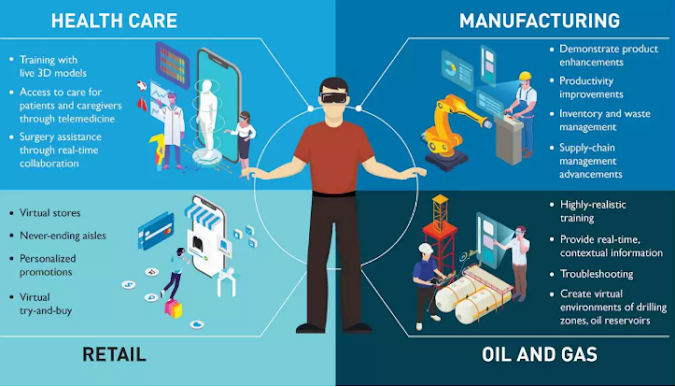Augmented Reality and Virtual Reality applications industries
Augmented Reality (AR) and Virtual Reality (VR) have applications in a wide range of industries, revolutionizing the way businesses operate and providing unique experiences to users. Here are some of the industries where AR and VR are making a significant impact:
Gaming and Entertainment: AR and VR have transformed the gaming industry, providing immersive experiences and interactive gameplay. Virtual reality gaming allows players to step into virtual worlds and engage with characters and environments, while augmented reality gaming overlays digital elements onto the real-world environment, creating exciting and interactive experiences.
Education and Training: AR and VR are revolutionizing education by providing immersive and interactive learning experiences. Virtual reality simulations allow students to explore historical events, scientific concepts, or complex machinery in a safe and engaging environment. Augmented reality enhances traditional textbooks by overlaying digital content, such as 3D models or additional information, making learning more interactive and accessible.
Healthcare: AR and VR have various applications in healthcare, from medical training to patient care. Virtual reality simulations enable medical professionals to practice surgeries, emergency scenarios, and complex procedures in a risk-free environment. Augmented reality assists surgeons during operations by overlaying patient data and imaging directly onto the surgical field, enhancing precision and efficiency.
Architecture and Design: AR and VR are transforming the way architects and designers create and present their projects. Virtual reality allows clients to experience architectural designs in a realistic and immersive manner before construction begins. Augmented reality can overlay digital models onto real-world environments, enabling architects and interior designers to visualize and refine their concepts.
Retail and E-commerce: AR and VR are revolutionizing the retail industry by enhancing the shopping experience. Virtual reality enables customers to try on clothes, accessories, or even test furniture placements in a virtual environment, improving purchasing decisions. Augmented reality allows customers to visualize products in their own space, such as trying out furniture or seeing how home decor items would look in their homes.
Manufacturing and Maintenance: AR and VR are improving manufacturing processes and maintenance operations. Virtual reality simulations help train operators and technicians in handling complex machinery or equipment. Augmented reality provides real-time information, instructions, and overlays on equipment, enabling technicians to perform maintenance tasks efficiently and accurately.
Tourism and Hospitality: AR and VR are enhancing the tourism and hospitality industries by offering immersive experiences to travelers. Virtual reality allows users to explore destinations, historical sites, or attractions from anywhere, providing a preview of what they can expect. Augmented reality can overlay digital information, such as historical facts or restaurant reviews, onto real-world locations, enhancing the overall travel experience.
Real Estate: AR and VR are transforming the real estate industry by providing virtual property tours and visualizations. Virtual reality enables potential buyers to explore properties remotely, saving time and effort. Augmented reality can overlay property information, such as room dimensions or property details, onto real-world spaces, providing an interactive and informative experience to buyers.
These are just a few examples of the industries where AR and VR are making a significant impact. As technology continues to advance, we can expect to see further integration and innovation in various sectors, enhancing productivity, creativity, and user experiences.


Post a Comment for "Augmented Reality and Virtual Reality applications industries"